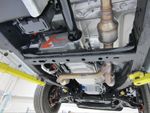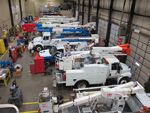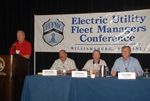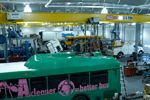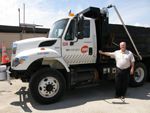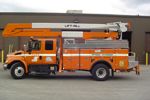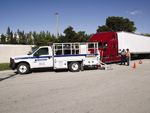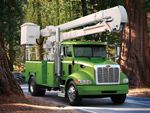During the 2011 Electric Utility Fleet Managers Conference, fleet managers detailed the successful approaches they’re employing for acquisition, maintenance and parts strategies in their operations.
Baltimore Gas & Electric
An affiliate of Constellation Energy, Baltimore Gas & Electric (BGE) provides electric and gas service in a territory of about 2,400 square miles surrounding the Baltimore metropolitan area of central Maryland. BGE Fleet Services, with 80 employees, including 46 technicians, manages a fleet of more than 1,500 vehicles and 400 pieces of equipment. The operation has a central shop at its headquarters location where all major repairs, new vehicle preparation and maintenance on local units is performed, as well as seven shops located throughout its service territory.
“Our replacement cycle has been based on economic life, the evaluation of units, user input and a review of maintenance records,” said Gill Nichols, supervisor, fleet engineering. “Budgetary and business cycle constraints can limit replacement activity, but our annual replacement plan is developed within current financial constraints and with the concurrence of users.”
BGE, Nichols reported, recently completed a five-year leasing contract. “A finance evaluation proved that leasing was less expensive than buying for BGE’s cost structure,” he said, “so we established a contract with a funding source and a separate services provider.”
BGE Fleet Services, Nichols explained, develops standardized specifications for each vehicle and equipment type in the utility’s operation. “A user-needs review identifies any necessary departure from standard offerings,” he added, “and modifications are controlled through an engineering review and user management approval of costs.”
Alliance agreements with major component suppliers have been established by BGE Fleet Services to provide for lower parts pricing and on-site training sessions. “The agreements cover most chassis, body and aerial components, and equipment types,” Nichols related. “These partnerships also allow us to collaborate with our suppliers on new product development and to serve as testing ground for new technologies.”
Preventive maintenance (PM) on the BGE fleet is usually based on manufacturers’ schedules, although BGE Fleet Services does modify schedules based on mileage, engine hours or fuel usage if those parameters are observed to be out of range. In addition, the fleet’s managers conduct data analysis of vehicles and equipment showing any higher than scheduled usage. In use is AssetWorks FleetAnywhere software. “We’ve been using this system for over 10 years,” Nichols stated. “It provides data on historic cost of repairs, labor hours, fuel usage, ownership costs and parts expenses, which we also use for setting charge-back rates and for benchmarking our operation.”
Maintaining the BGE fleet is a team of PM trainees, PM technicians, master technicians and senior master technicians. “We established these roles so our technicians can move from job to job based on attaining required certifications, meeting established performance standards and job qualifications, and demonstrating the ability to perform required tasks,” Nichols said.
“Our technicians are provided with information about what is required to advance and are given opportunities to advance at their own pace,” Nichols continued. “Manpower utilization in our shops is planned on a monthly basis using estimated repair activity and PM schedules. Shop-to-shop labor transfers are made to manage spikes in workload, vacations and long-term medical absences.”
BGE Fleet Services makes extensive training opportunities available to its technicians. An established program for new hires encompasses seasoned workers as well as high school graduates. The highly structured program teaches shop functions, computer systems, safe work practices, tool and equipment use, and basic elements of maintenance and repair work. Trainees are instructed daily on how to perform PMs and other repairs by working in the fleet’s central shop with a senior master technician.
Manufacturer training sessions are also provided to trainees and all technicians to familiarize them with new models, systems and functions of vehicles and equipment. Additionally, a contracted training program has been developed to provide basic through advanced training in electronics, braking systems, engines, hydraulic systems and other areas.
BGE Fleet Services has also worked with all of its major suppliers to establish warranty repair agreements, enabling the fleet’s technicians to perform repairs on covered items. “We actively manage the warranty recovery process, set annual recovery goals and include this in our bonus performance award program,” Nichols related.
Parts inventories are managed closely at BGE Fleet Services. Established through competitive bidding, contracts are in place for high volume items using specialty suppliers where applicable and larger suppliers for the majority of stocked parts. The fleet’s Operations & Support Unit monitors and manages inventories, orders stock parts, and collaborates with shop personnel to add or delete parts from stock based on usage patterns. The group also assists in ordering specialty or long-lead items.
Successful acquisition, maintenance and parts programs, Nichols pointed out, are the result of finding effective solutions on a consistent basis. “We address short-term issues through teams composed of members from all areas within the department and customers,” he explained.
“We also hold an annual planning conference to develop short- and long-term goals and initiatives for the department,” Nichols concluded. “Prior to the conference, feedback is solicited from all members of the department about improvement ideas or suggestions, and identification of problems or issues that need to be addressed. Department management and leadership use the responses to formulate strategies to improve performance, address issues and develop goals to pursue.”
Progress Energy
Covering a territory that encompasses 34,000 square miles across North Carolina and South Carolina and 20,000 square miles in Florida, Progress Energy serves more than 3 million customers. Its fleet of nearly 3,900 vehicles and equipment is maintained in 26 regional garages by 124 employees, including 88 technicians, along with supervisors, administrators and other support personnel.
The Progress Energy fleet includes 2,500+ light-, medium- and heavy-duty vehicles from a variety of manufacturers. Also in the operation are more than 1,300 pieces of equipment including trailers and off-road excavating equipment.
“We have a $50 million annual operational and maintenance budget,” reported Gary Butler, Progress Energy Carolinas manager of fleet assets and maintenance. “About one-third of that covers vehicle ownership, one-third is for maintenance and the balance is for fuel.”
Each of those cost areas is then the focus of efforts by the fleet’s managers. Equipment utilization is reviewed periodically to ensure proper allocation of the fleet, and vehicles can be moved after a review of job duties, equipment sizing and other considerations.
Current replacement cycles for the Progress Energy fleet are five years or 125,000 miles for light-duty vehicles, seven to eight years for medium-duty models and 11 years for heavy-duty units. Service buckets are usually replaced after four to five years and trailers in the operation last 20 years.
The Progress Energy maintenance operation handles 93 to 95 percent of the fleet’s maintenance and repair needs in-house, including using 20 traveling preventive maintenance trucks. Day and night shifts also complete dielectric testing on aerial units.
Shops are manufacturer-approved warranty repair centers for GM, Ford, Dodge, Freightliner, International, Sterling, Western Star, Altec and Terex. Warranty recovery utilizing the services of a third-party warranty administrator totaled $45,000 in 2010 and was projected to rise to $75,000 to $100,000 in 2011, Butler reported.
About 5 to 7 percent of the Progress Energy fleet’s maintenance and repair work is outsourced, including tire work and alignments, windshield and body repairs, automatic transmission work and hydraulic cylinder rebuilding.
“We occasionally outsource maintenance due to workload and logistics considerations, and when we identify savings opportunities,” Butler related. “Current maintenance intervals have been set based on regulatory and manufacturer requirements. Preventive maintenance intervals can also vary depending on make, model and application while costs can be affected by hourly labor rates for technicians, which are dependent on progression in salary and other variables.
“Our preventive maintenance intervals are also based on oil sampling,” Butler added. “The data indicates we could extend the intervals, but we established a conservative approach and set mileage limits to ensure that extremely excessive mileage does not occur.”
Parts supplier agreements in place at Progress Energy are resulting in cost savings. Costs are kept in check using volume pricing and rebates, centralized billing and reporting and tracking capabilities.
Progress Energy’s fleet managers also pay close attention to fuel costs and use the information to bolster fuel consumption awareness, including idling practices, routes, weight and stop/start operations. Fuel hedging serves as insurance against steep price increases.
An all-around approach, Butler noted, is minimizing rising vehicle costs at Progress Energy. “We have vehicles and equipment, and driver teams that address issues like utilization, maintenance and fuel consumption,” he explained. “Management system and benchmarking data supports our cost reduction initiatives. In the last 10 years, we’ve held costs flat and absorbed labor increases.”
Oklahoma Gas & Electric
Serving 765,000 customers in a 30,000-square-mile service territory in central Oklahoma and western Arkansas, Oklahoma Gas & Electric (OGE) fields a fleet of more than 2,400 pieces of equipment, including 1,300 light-, medium- and heavy-duty vehicles. The fleet is maintained in 11 garages, including one central facility in each of the utility’s larger districts that supports at least one smaller district and/or power plant.
OGE employs 23 mechanics and three garage supervisors as well as eight support personnel in its maintenance operation. Senior mechanics are assigned to one-person shops, mobile service units or as lead technicians in larger facilities. The staff also includes journey and apprentice mechanics as well as interns.
“Many of our garages are one-person operations,” said Herb Kramer, fleet maintenance supervisor. “We move larger jobs to external sources or to our main shop, or we move resources to accomplish the work. We do not want the one mechanic in a facility to be overwhelmed or to create a backlog with a larger time-consuming job. All but three mechanics work from 3 to 11:30 p.m.,” he added, “which means if there is a problem during the day it is repaired that night and the unit is back in service in the morning.
“We handle 75 to 80 percent of the work our fleet requires internally,” Kramer continued, “and we outsource work that we feel we cannot handle as cost effectively as an outside supplier. That may have to do with our available resources, but in all cases we limit the number of suppliers we use.”
At OGE, Kramer reported, all bodywork, windshield repair and virtually all tire work is outsourced. In addition, the fleet outsources 80 percent of light-duty vehicle warranty work, 10 percent of preventive maintenance on those vehicles, and 70 percent of repairs and larger issues found during PMs on light-duty models. Dealers servicing the fleet are required to provide pickup and delivery services.
“We’re very focused on vehicle inspection,” Kramer stated. “Engine oil is sampled at every drain interval and hydraulic oil is tested once per year unless contamination is found. Every time a vehicle is in a shop we try to correct anything we find. We created a checklist so mechanics know what to focus on and we started requiring shop supervisors to check 10 to 20 percent of all work.”
During and between routine PMs, OGE shops are also focusing closely on vehicles and equipment with higher utilization, and those with harder duty cycles. “When we find high-mileage newer vehicles,” Kramer noted, “we move them to areas with lower utilization. That helps us stay on track for replacement cycles and reduces repair costs.”
For parts, OGE is moving from one to three suppliers. “The theory was that we could do a better job of managing costs with one supplier,” Kramer related, “but that made it hard to compare, and having one pipeline increased downtime. To reduce downtime we allowed mechanics to buy locally if it meant they could get the vehicle back in service, and that drove up costs. With our new arrangement we realized a 20 percent reduction in parts costs.”
OGE’s other practices are paying off as well. A proactive approach to maintenance and repairs has reduced downtime and breakdowns, cutting the number of service calls from more than 100 to fewer than 10 per month. Increased uptime, measured as mean time between repairs, has improved.
“That was partially from upgrading equipment and moving high-use vehicles to lower-use areas,” Kramer said. “It’s also a result of better diagnostics and parts availability, as well as keeping mechanics focused on completing a job by giving them the responsibility to manage their own schedules.
“When we started down this path our costs started to rise,” Kramer continued, “because we were fixing things that were broken but never reported. Over time we started seeing our efforts pay off. Today we’ve realized a $700,000 drop in maintenance costs, and a reduction in annual tire expenses from over $950,000 to $550,000.”
Critical to this success, according to Kramer, is meeting with major vendors three or four times per year, and having information on the fleet’s operation and analyzing that data often. OGE also uses the benchmarking services of Utilimarc.
“We measure everything possible and question it regularly,” Kramer stated, “including mean time to repair data, and repair costs for internal and outsourced work. We also evaluate warranty and utilization. Overall, we’re focusing on reducing our annual budget from a variable $11 to $15 million to a lower and steady $9.5 million per year.”
Editor’s Note: The annual Electric Utility Fleet Managers Conference will be held June 3-6, 2012, in Williamsburg, Va. For more information, visit www.eufmc.com.


